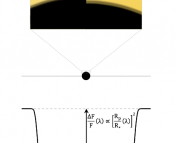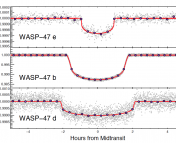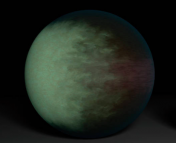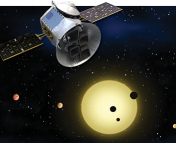Authors: Diana Powell, Tom Louden, Laura Kreidberg, Xi Zhang, Peter Gao, Vivien Parmentier
First Author’s Institution: University of California, Santa Cruz, California, USA
Status: Published in The Astrophysical Journal [closed access]
A crash course on transmission spectroscopy
Much of our knowledge about the atmospheric properties of exoplanets comes from transmission spectroscopy. An exoplanet’s apparent size (inferred from the amount of starlight it blocks out) varies with wavelength as molecules (plus atoms, ions, clouds or hazes) in the upper layer of the exoplanet’s atmosphere absorb different wavelengths of the star’s light. Clouds are especially important, as they affect atmospheric spectra and inhibit our ability to learn about the fundamental atmospheric properties for the majority of exoplanets (one example of this is shown in Figure 1). Not only are atmospheric clouds ubiquitous in our solar system, but many exoplanets show strong evidence for clouds (for example, GJ 1214b and HD 209458b)!
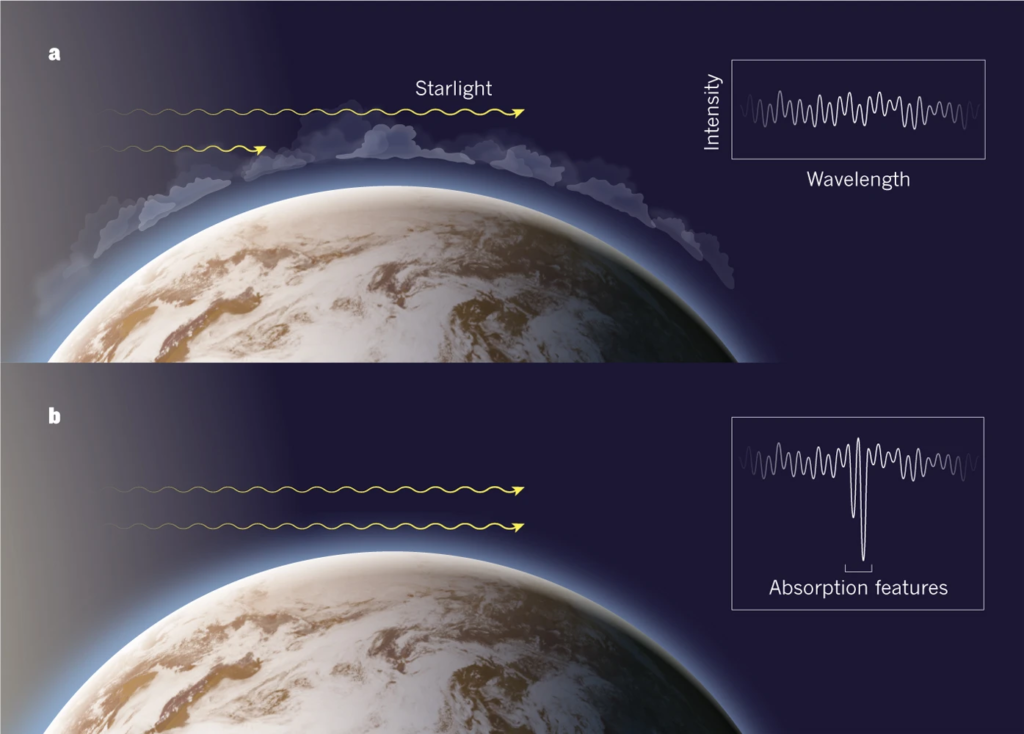
Typical transmission spectra analysis methods, like atmospheric retrievals, assume a 1D atmosphere that only changes radially, because working with detailed 2D/3D models is computationally challenging. However, as you might have guessed, planets are 3D! The transmission spectra we collect in our telescopes are a combination of multiple spectra from different locations in the atmosphere. Atmospheric composition and temperature can vary in 3D, and the distribution of clouds on a planet can also be wildly inhomogeneous, i.e., non-uniform.
The case of hot Jupiters
A category of exoplanets called hot Jupiters (Jupiter like gas-giants orbiting very close to their host stars) are especially likely to have non-uniform cloud distributions. Because hot Jupiters are tidally locked, their daysides and nightsides have huge temperature contrasts. Cloud properties are highly sensitive to how the temperature of the atmosphere changes with height, longitude and latitude (referred to as the atmosphere’s “local thermal structure”). So, we expect that a hot Jupiter will have clouds with diverse properties (for example, on Earth, water clouds form where it is cold enough for water to condense). In particular, models show that for many hot Jupiters, the thermal structure on the east limb is substantially hotter than the temperature on the west limb (see Figure 2). Since various gases condense to form clouds at different temperatures, this leads to clouds with very different properties forming on the east limb versus the west limb.

We have evidence for non-uniform clouds through phase curve observations of hot Jupiters (and brown dwarfs), where we observe how the reflected starlight from the planet changes as the planet orbits its host star. However, various difficulties with obtaining phase curve measurements make this method of probing cloud cover difficult to generalize to the vast majority of exoplanets. One promising alternative is transmission spectroscopy. Today’s paper explores if transit measurements of hot Jupiters with the James Webb Space Telescope (JWST) can provide a strong signature of non-uniform clouds.
How do non-uniform clouds affect the transmission spectrum of a hot Jupiter?
In today’s article, the authors present transmission signatures of non-uniform cloud cover on hot Jupiters that should be observable using the JWST, scheduled for launch later next year. First, the authors try to understand how temperature structure and composition differences produce these non-uniform clouds, and consequently, the observed transmission spectrum of the planet. We should also note that because hot Jupiters have very high equilibrium temperatures (~2000 K), the clouds are composed of molecules that can condense at these temperatures, like silicates, aluminum and titanium oxides (wild!).
The authors simulate cloud formation on various Jupiter-sized, tidally locked planets orbiting a solar type star. The differences in cloud structure between the east and west limbs of these model hot Jupiters manifest as differences in the transmission spectra of their east and west limbs. An example transmission spectrum for a planet with equilibrium temperature of 2000 K is shown in Figure 3 and discussed below:
- Firstly, the model transmission spectra are different on each limb of the planet, often by as much as ~1000 ppm or parts-per-million (also see Figure 7 from the paper).
- Secondly, the west limb spectra appears very flat with subdued molecular features, because it’s much more cloudy.
- Thirdly, the overall absorption in the east limb is higher (larger transit depth values), especially at shorter wavelengths, because clouds form at much higher altitudes on the east limb as it is hotter. Thus the apparent radius of the planet at shorter wavelengths, where clouds are opaque, is much larger on the eastern limb than the western limb, creating a ~1000 ppm difference in transit depth.
- Finally, it’s interesting to note that the east limb, despite forming fewer clouds, provides a more clear signature of the properties of the clouds (the aluminum + silicate bump at ~ 10-20 microns) present in the atmosphere.
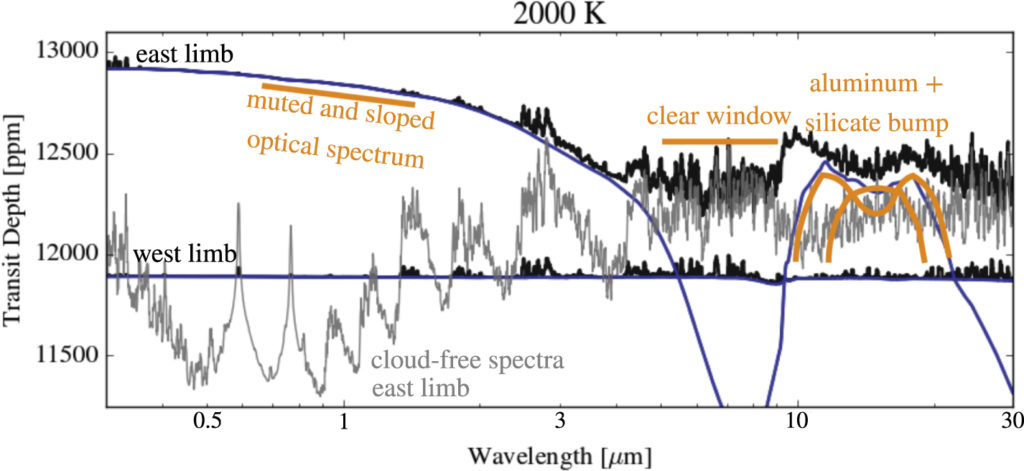
Strategies for observing cloud non-uniformity with JWST
The authors explore if JWST will be capable of detecting non-uniform clouds on exoplanets through transit curve observations.

- They first investigate how the transit curve of a non-uniform exoplanet atmosphere compares with one with a uniform atmosphere. They find that the transit lightcurves show characteristic differences (Figure 4), which also vary with wavelength (Figure 14 in the paper). Importantly, the magnitude of these differences are within the detection capability of JWST.
- Next, the authors investigate if cloud properties (uniform v/s nonuniform) can be recovered from simulated JWST transit curves (fake JWST data) in two wavelength channels (at 1 and 6 microns). They simulate lightcurves for the two wavelength regions, using a JWST simulator, and then attempt to fit these lightcurves and recover the parameters used to initially generate the model. As expected, they find that a model with a non-uniform atmosphere, especially when clouds are included, does a much better job fitting the synthetic data as compared to a model with a uniform atmosphere (Figure 17 from the paper).
To sum it up…
This work provides a detailed insight into how the differences of cloud distribution on the east and west limbs of a particular kind of exoplanet — hot Jupiters — are reflected in its transmission spectrum and transit light curves. The authors provide techniques which should enable us to uncover cloud inhomogeneities (or non-uniformities) with the much awaited JWST, as a complementary method to the more common phase curve studies of exoplanet atmospheres. This work is a key step forward as the exoplanet community moves towards understanding exoplanet atmospheres as inherently complex three-dimensional entities.

